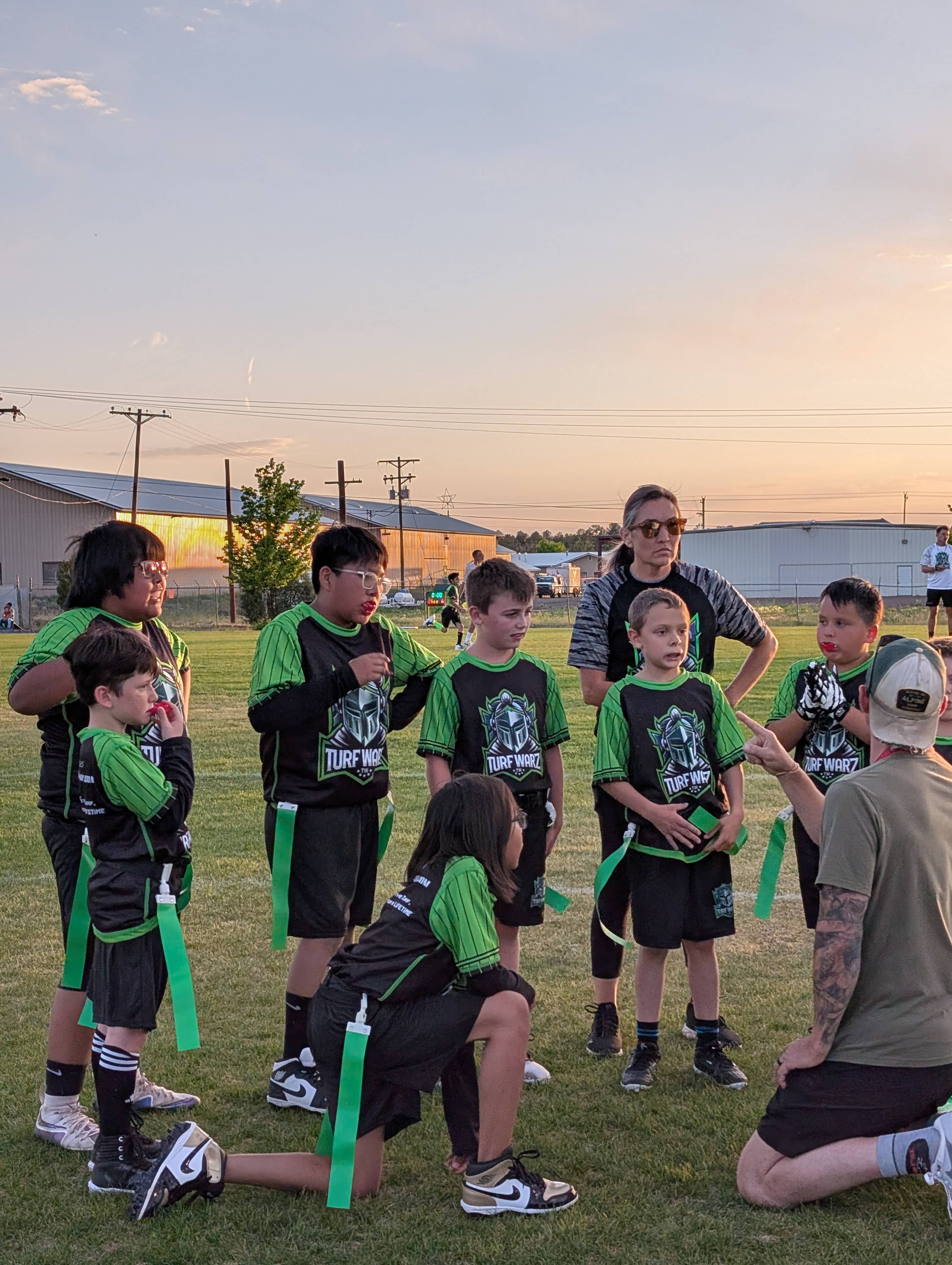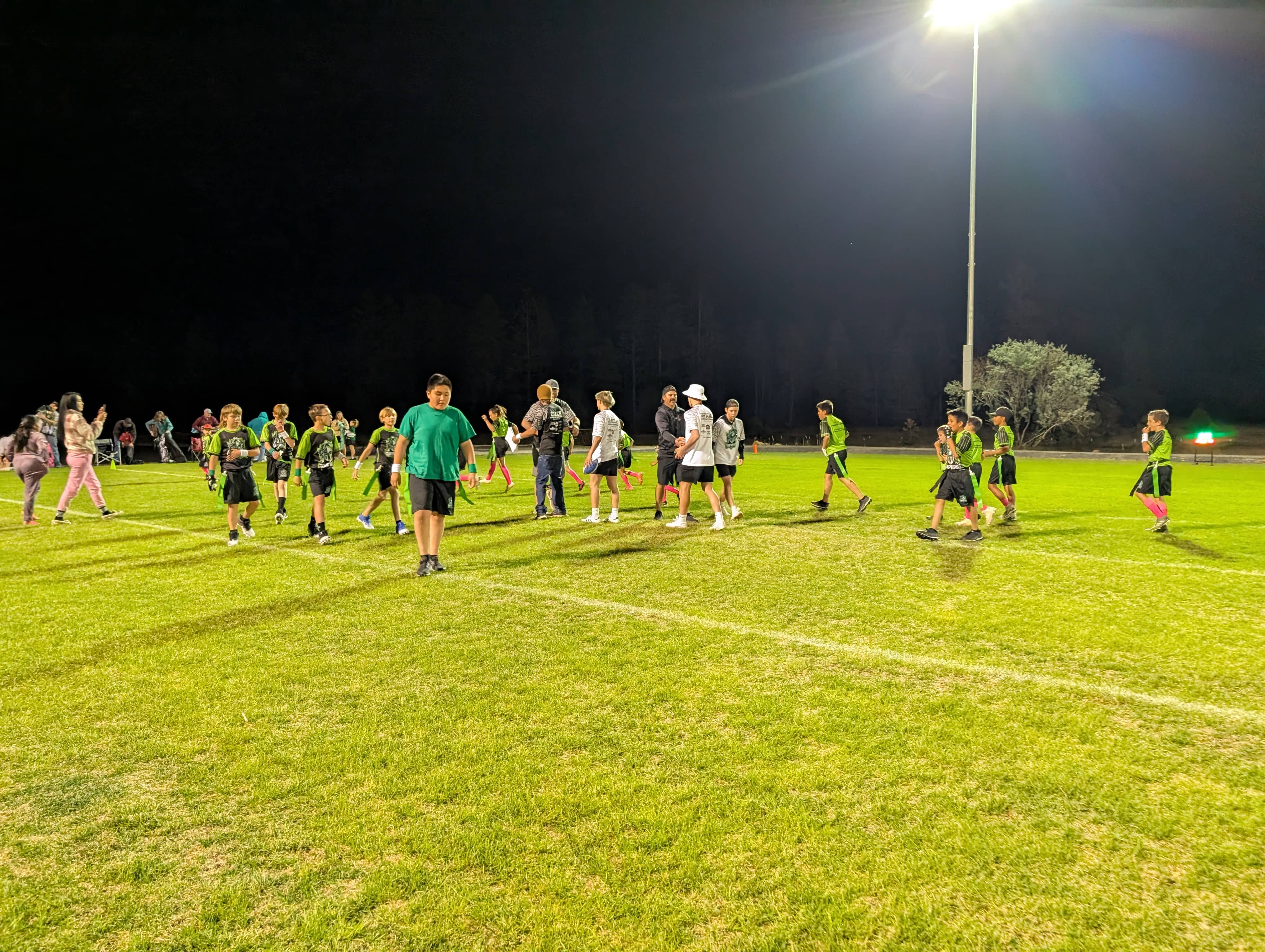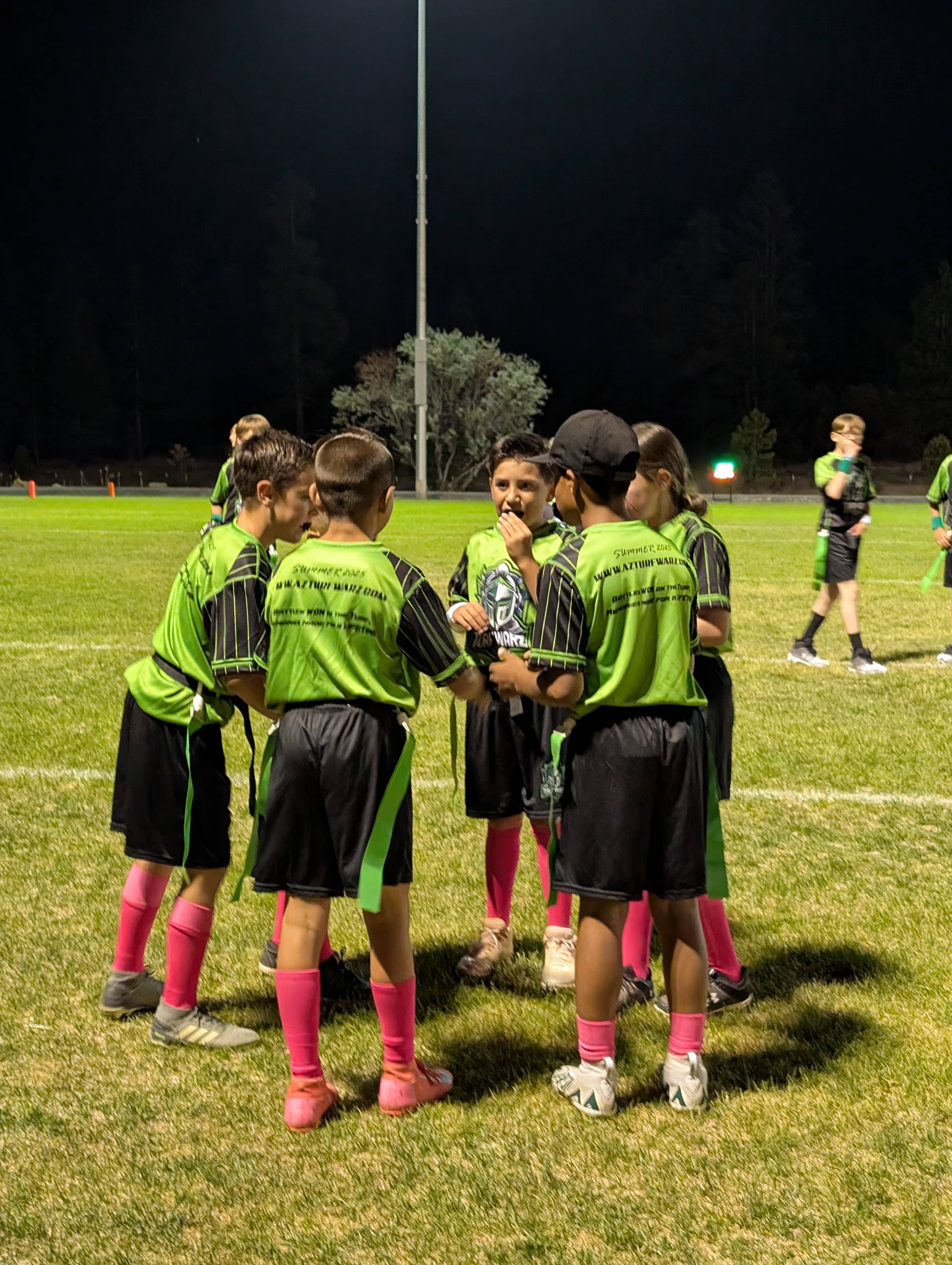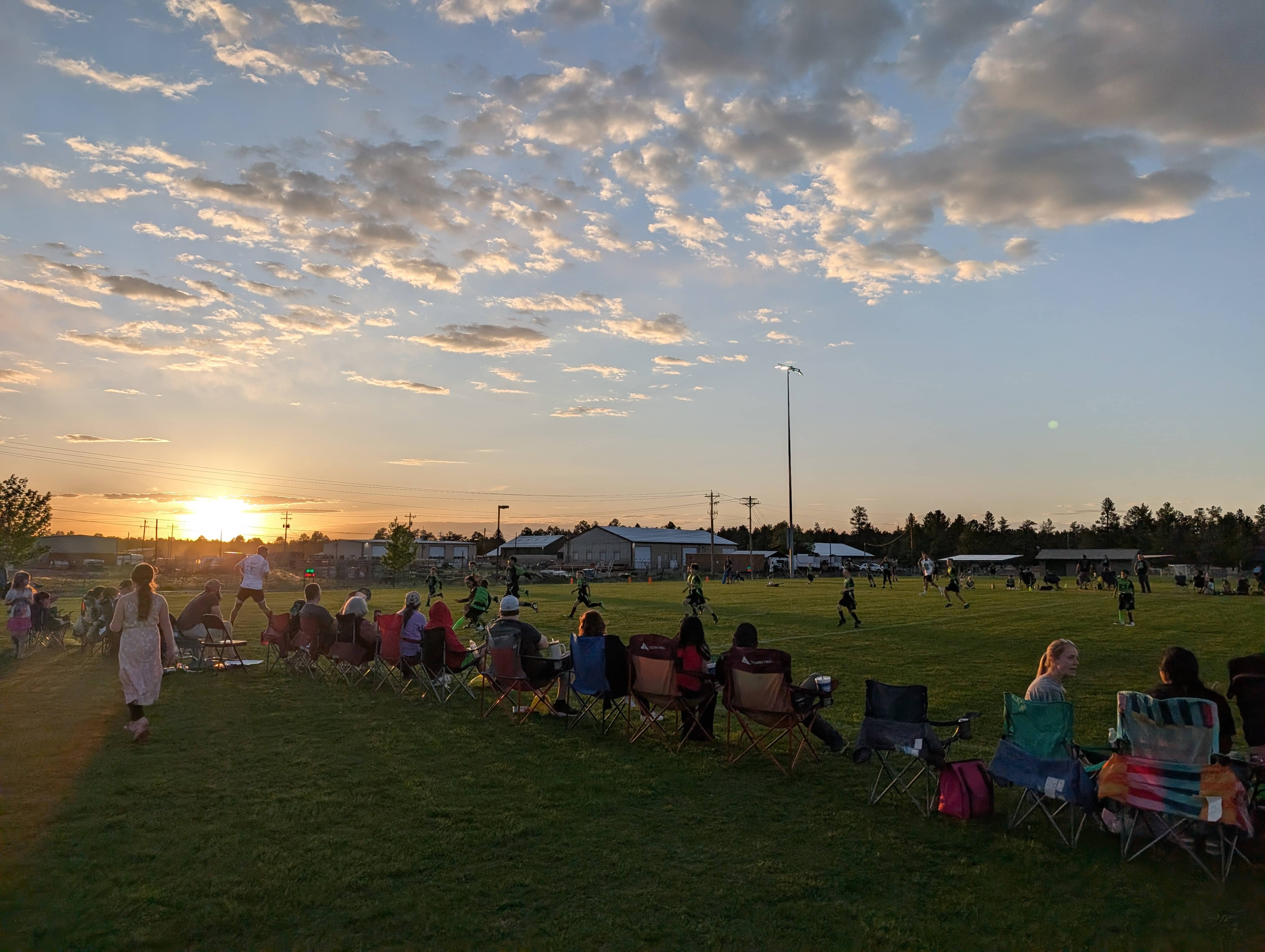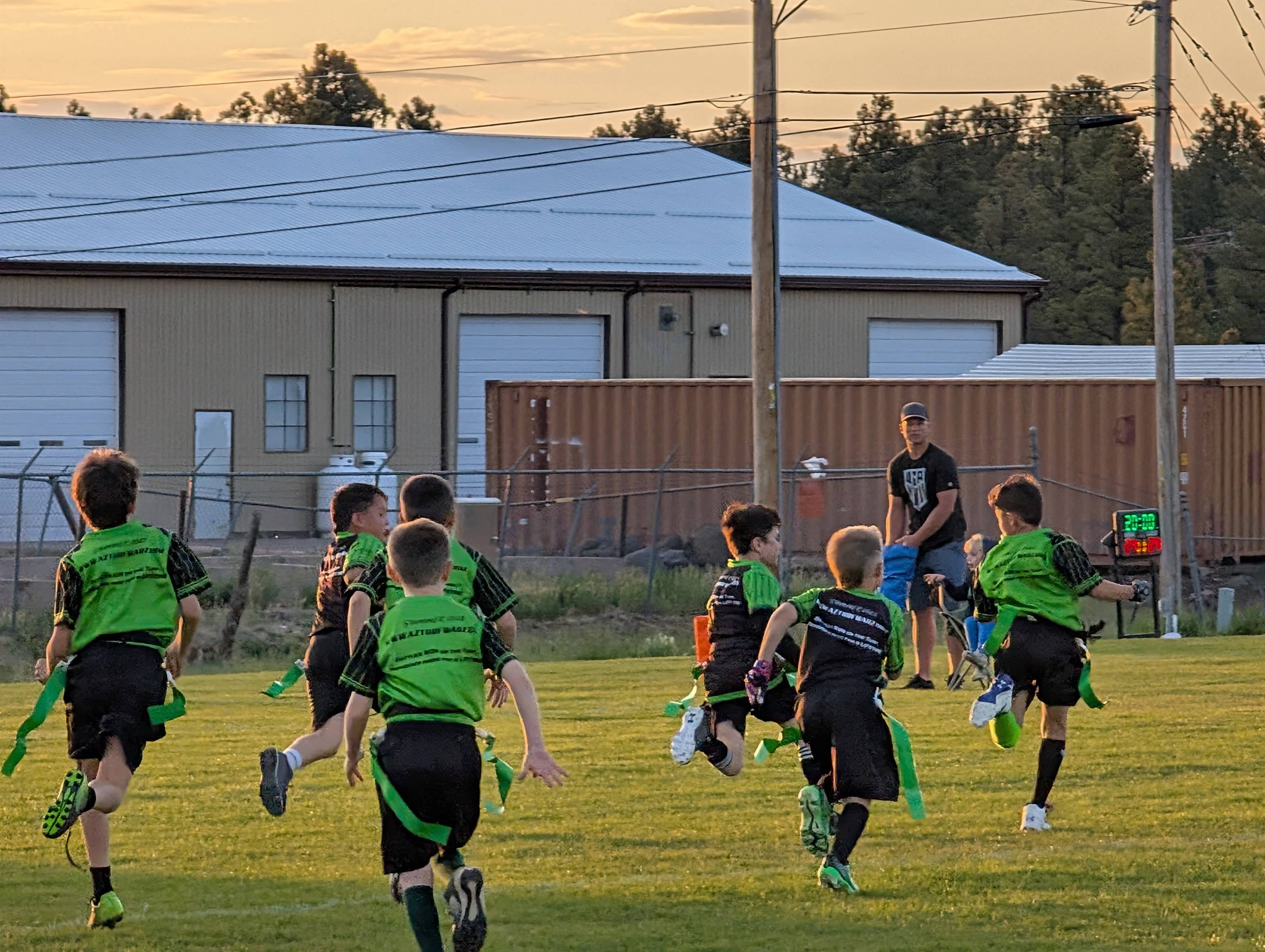Get in Touch
Reach out to AZ Turf Warz Youth Flag Football League for any inquiries or support. We are here to assist you with registration, volunteering, and any other questions you may have.
- Emailinfo@azturfwarz.com
- AddressPhoenix, AZ 85014
Love This Website? Get One for Your Business!
Enjoy this lightning-fast, beautiful website? Want one for your White Mountains business? Get a custom-coded, hand-built website at 50% OFF and support youth flag football at the same time!
Become a sponsor and help grow youth activities in the White Mountains! Work directly with Carlo, the owner & developer.
Official League Frequently Asked Questions
Browse common questions about gameplay, conduct, eligibility, and team rules for AZ Turf Warz. These FAQs are based on our official rulebook to help parents, players, and coaches understand how the league operates.
Games begin with a coin toss between team captains. The visiting team calls the toss. The winner chooses to kick or receive, while the other selects the goal to defend.
Kickoffs vary by division — either from midfield or the 12-yard line, depending on the age group.
Teams have four plays to cross midfield. Once they do, they get four additional plays to score.
Teams may either 'go for it' or elect to punt.
Yes, unless the intercepting team is ahead by 28+ points. In that case, the play ends at the interception spot.
Teams switch sides, and the team that was on defense at the start begins on offense in the second half.
Matches consist of two halves, each lasting 20 minutes, with a running clock throughout the game.
Within the last minute of the second half, the clock halts for dead balls if the point difference is 8 or less.
Halftime spans five minutes between the two 20-minute halves.
Teams have 30 seconds to commence play once the ball is ready for the next down.
Each team is allocated one 60-second timeout per half, applicable in both regular and postseason play.
No, ties at the end of regulation do not lead to overtime in the 4U and 6U groups. Other divisions use overtime during tournaments or playoffs.
The play area measures 30 yards in width by 70 yards in length, including two 10-yard goal zones at each end and a central line for marking progress. Field size may adjust based on location availability.
These zones are positioned 5 yards before each progress line and limit certain play types to encourage strategic gameplay and prevent short-yardage power runs.
Within these designated zones, teams are prohibited from running plays and must use passing plays only, including those initiated by handoff. The 4U and 6U divisions are exempt from this rule.
Players stepping on sideline boundaries are deemed out of play immediately.
No, the 4U and 6U divisions do not permit blitzing strategies during gameplay.
No, the pass-only zone rules are waived for the youngest divisions (4U and 6U), allowing them more flexibility in their offensive strategies.
Players must be officially registered with payment, signed waiver, contact info, and parent conduct agreement.
Based on the player's age on the first game day of the season. Divisions include 4U through 14U.
No. Each player may join only one team per season unless approved by the commissioner.
No. 'Playing down' is not allowed. Players may only play in their age group or older.
The game is forfeited, and the team may face suspension.
Teams must have 6–12 players. Adjustments require league approval.
Teams may play with as few as 4 players. If fewer, the game is forfeited.
Yes, but official games require at least 5 players to start.
Home teams wear dark jerseys, and away teams wear light jerseys.
All coaches must complete mandatory background checks, coaching certification, and specific training in concussion awareness and safety standards.
Yes, most coaches are volunteers, often parents or relatives, who aim to teach and enrich the game for players through guidance and leadership.
Coaches develop and execute planned practices, organize weekly team skills sessions, communicate policies, and maintain positive role modeling in sportsmanship, health, fitness, and character development.
Coaching presence on the field is permitted only in certain younger age divisions to guide players directly. Older divisions have specific sideline coaching rules.
Coaches handle teams consisting of 6-12 players and are responsible for team practices, skills training, and game participation.
Coaches focus on community service and positive impact on youth, creating a safe and enjoyable environment while encouraging parent participation in team activities.
Parents must commit to encouraging and supporting all players, coaches, and officials positively during games and practices through respectful spectating.
Parents must ensure their child's safety, health, and emotional well-being are prioritized over competitive success and winning desires.
Yes, parents must guarantee their presence or that of a legal guardian at all AZTurfWarz Flag Football events involving their child.
Parents should back the efforts of coaches and officials to foster a constructive and enjoyable experience for everyone involved, remembering the sport is for youth benefit.
Parents should encourage their child to respect fellow players, coaches, fans, and officials while actively contributing to making sports enjoyable.
Yes, AZTurfWarz Flag Football reserves the right to refuse service to individuals disrupting the safety and well-being of participants.
Scoring a touchdown is worth 6 points.
Teams can attempt a 1-point conversion from the 5-yard marker (passing plays only) or a 2-point conversion from the 12-yard marker (running or passing plays allowed).
A safety is worth 2 points and occurs when the ball carrier is downed in their own goal area through flag capture, stepping out of bounds, or other specified conditions.
Once a team leads by 28 or more points, the trailing team gets one offensive series to score. If they fail, the game transitions to scrimmage with a running clock.
Yes, interceptions during extra point attempts can be returned for a score, valued at 2 points regardless of the offensive team's chosen attempt.
For 4U, 6U, and 8U divisions, safeties during punt and kick returns are not recognized; the ball is placed at the 5-yard line instead. All other divisions follow standard safety rules.
Direct quarterback runs are prohibited across all age divisions. However, in 8U and above, quarterbacks may run when the defense breaches the line of scrimmage from the designated rush marker, excluding no-run zones.
The ball's position is marked where the runner's foremost foot is at the flag's pull, not the ball's location.
Yes, multiple handoffs are permitted within the offensive play, and players receiving handoffs may attempt passes from behind the scrimmage line.
Leap-based advances by the ball carrier are banned to prevent flag guarding. However, jumping to avoid collision is acceptable if not used for flag guarding.
Yes, lateral passes are legal both behind and beyond the scrimmage line, but turnovers apply on dropped lateral attempts.
No, no form of blocking or screening is allowed in flag football.
All forward passes must originate from behind the line of scrimmage. Shovel passes are permitted only outside the no-run zone.
Quarterbacks have a 7-second window to release a pass. Failure results in a penalty, but play continues to allow for potential defensive plays.
If no interception occurs following a delayed pass, the ball returns to the original line of scrimmage for the next play.
No, once a handoff is made, the 7-second pass rule is no longer applicable to that play.
All players are eligible to receive passes, including the quarterback if the ball has been handed off behind the line of scrimmage.
A catch is considered valid if the receiver has at least one foot inbounds during the reception and maintains possession.
If both an offensive and defensive player gain possession simultaneously, the offense retains possession.
If a lateral is fumbled, the ball is marked down where it hits the ground. Defensive interceptions of a lateral can be advanced.
Punting is mandatory for divisions 10U and older. The 8U division can replace punts with passes, while 4U and 6U divisions place the ball at the opposing team's 5-yard line after a punt decision.
No, upon declaring a punt, defenders must stand behind the rush cone and are unable to rush the punter.
The punter has 7 seconds post-snap to execute the punt, and a proper long snap is required.
No, declared punts must be followed through without fakes.
Punts exiting play are marked where the ball left the field.
Dropped balls or those hitting a receiver then the ground are dead at the drop point, with specific handling rules for each team regarding touched balls.
Games start with a referee-whistled kick-off, with positioning varying by division.
No turnovers on kick-off or punt returns, except through lateral pass interceptions or safety occurrences.
Receiving teams can choose to start where the ball exited play or request a re-kick with a 5-yard penalty against the kicking team.
Kicks must travel at least 7 yards. Failing to kick 7 yards results in a penalty and re-kick.
Following a touchdown and extra point, the scoring team kicks off to the opposition.
The kicking team must stay behind the ball until the kick is made to avoid penalties.
Rushers must start at least 7 yards from the line of scrimmage, with any number allowed to rush post-snap.
Yes, post-handoff, all defenders are permitted to cross the line of scrimmage and rush.
A marker or official designates the 7-yard rush boundary for defensive players.
Contact with the QB must avoid illegal actions like hitting the arm, hand, or head, or unnecessary roughness, with penalties for violations.
A sack in the offensive end zone results in a safety award worth 2 points.
No, offensive players can't block or impede a rush intentionally, though officials make judgment calls on incidental contact.
The game commences with the snap and continues until an official deems the play concluded through various conditions like flag capture, out-of-bounds movement, or scoring.
Yes, teams may substitute players during any stoppage in play.
No, mimicking the opposing team's signal calling by the defense is prohibited.
A quarterback intentionally discarding the ball without a target incurs a penalty, emphasizing fair play and strategic passing.
Play concludes when the ball contacts the ground, flag is captured, player goes out-of-bounds, or if the ball carrier contacts the ground with a knee or arm, or loses a flag inadvertently.
Plays proceed despite neutral zone violations, with penalties assessed post-play after officials mark the scrimmage zones.
Offensively, at least one player (typically the center) must be on the line of scrimmage, with a maximum of five allowed. The quarterback is positioned off the LOS.
One player may move parallel to the LOS during the snap but cannot move towards the LOS. Simultaneous motion among players is permitted prior to the snap.
All players must be stationary for one second before the snap unless they are the player in motion.
The center is required to snap the ball between their legs to a backfield player in a swift, continuous motion.
The quarterback must be positioned off the line of scrimmage, behind the center and other linemen.
Yes, only one player may be in motion during the snap, and they must move parallel to the line of scrimmage, not toward it.
A pull is considered legal only when the ball carrier has complete possession of the ball.
Yes, defenders may dive to pull flags but are prohibited from tackling, holding, or charging through the ball carrier.
No, it's against the rules to strip or attempt to remove the ball from the carrier's hands at any time.
If a player loses their flag accidentally during play, they're considered down upon ball possession.
The ball carrier cannot block access to their flags by using stiff arms, lowering the head, hands, arms, or shoulders, or covering the flags with the football or jersey.
No, pulling flags from a player without the ball is not allowed and results in a penalty.
Ball carriers must make a distinct effort to avoid direct contact with defenders. Failure to do so results in a 10-yard penalty for charging.
Officials will pay close attention to the direction of the ball carrier's feet at the moment of contact to ensure safety and adherence to the rules.
Incidental contact may occur, but deliberate contact, charging, or failure to avoid defenders results in penalties to maintain the non-contact nature of flag football.
Ball carriers must make evasive maneuvers and cannot run directly into or through defenders, maintaining the safety-focused spirit of flag football.
Yes, unnecessary roughness, charging, and deliberate contact all result in penalties and potential ejection depending on severity.
Through strict no-contact rules, proper equipment requirements, flag pulling instead of tackling, and penalties for any charging or unnecessary contact.
AZTurfWarz Flag Football supplies an official game ball for both practice and match use for all teams.
The 4U Division utilizes red mini footballs.
6U & 8U Divisions employ the Pee-Wee size football (Nerf Black Football). However, 8U all-girls divisions also use the black Pee-Wee football.
10U, 12U, and 14U Divisions are assigned the JUNIOR size football (White Flag Nerf football). The 10U all-girls division uses the black Pee-Wee football, while 12U all-girls uses the Junior white Flag Football.
Teams must use the appropriate football size for their division; failure to comply results in game forfeiture.
Always confirm with the local AZTurfWarz Flag Football League Commissioner regarding division-specific regulations and equipment requirements.
Players receive an official AZTurfWarz jersey and flags from AZTurfWarz Flag Football.
Yes, team jerseys are mandatory for game participation, with home teams wearing dark and away teams wearing light jerseys.
Jerseys should be tucked in if they extend beyond the belt line, and belts must be secure to avoid flag-guarding calls.
Footwear must consist of rubber-soled sneakers or cleats without metal spikes for safety.
Yes, mouthguards are obligatory for all players during games to ensure safety.
No, all potentially hazardous accessories, including jewelry and watches, must be removed prior to gameplay.
Yes, the AZTurfWarz Flag Football weather policy is tailored to each location, considering the league's needs and field specifics.
Consult the local AZTurfWarz Flag Football League Commissioner for detailed policies on weather-related game adjustments and procedures.
Safety measures include mandatory mouthguards, no-contact rules, proper equipment requirements, concussion protocols, and strict penalty enforcement for dangerous play.
Weather decisions are made locally by each league commissioner based on safety considerations, field conditions, and local weather policies.
Games may be postponed, relocated, or cancelled based on local weather policies. Check with your league commissioner for specific procedures.
Officials and the league commissioner have authority to suspend or stop games if weather conditions become unsafe for players and spectators.
Any player showing signs of head injury must be cleared by a medical professional before returning to play.
Only designated coaches and officials are allowed unless game officials grant permission.
No. However, a legal guardian must be present during all league activities involving their child.
Unsportsmanlike conduct can result in penalties, ejection, or removal from the premises.
No. Use of tobacco or severe language results in immediate ejection.
Acts deemed dangerous or harmful by officials incur an unsportsmanlike penalty. A second violation by the same player leads to ejection.
Intentional cheating results in game forfeiture and a suspension pending league commissioner review.
Players should hand flags back post-pull; throwing them is considered unsportsmanlike and may result in penalties.
AZTurfWarz Flag Football enforces strict rules to maintain a family-friendly environment, with immediate actions for those compromising it, including venue bans and potential team forfeits.
For safety, spectators are required to remain at least 10 yards from the sidelines at all times.
Non-compliant coaches, fans, or parents can cause game forfeiture if they refuse to leave after receiving a warning from officials.
All penalties are called by referees, who also judge incidental contact and have final authority on all calls.
Only head coaches may seek rule clarifications from referees, but they cannot dispute judgment calls made by officials.
5-yard penalties include illegal equipment, offside, illegal motion, delay of game, and similar minor infractions.
10-yard penalties are applied for roughing the passer, taunting, unsportsmanlike conduct, and other more serious infractions.
No, a game cannot conclude on a defensive penalty, with the offense having the option to decline the penalty.
Offenses penalized in no-run zones must pass in their next play, maintaining the zone's pass-only requirement.
Only players officially rostered for the current season are eligible for tournament play. Violations result in immediate disqualification from the tournament or playoffs with no exceptions.
Yes, to resolve ties, an overtime period will be implemented in all divisions during tournament or playoff scenarios.
Each team is granted two 30-second timeouts per half throughout tournaments and playoffs.
Participation in State, Regional, and National Tournaments mandates compliance with official flagfootball rules. Consult your local commissioner for specifics.
Wins and losses primarily determine league standings. In case of ties, the team with the fewest points allowed (PA) will have the advantage.
The league emphasizes player development over accolades during the regular season and does not award division leaders to maintain this developmental focus.
Have a question?
We're here to help. Contact us for more information about our services.

How To Get Started
Follow these steps to join AZ Turf Warz Youth Flag Football League. We make the process simple and straightforward for you.
Contact Us
Reach out to us through our website or phone to get more information and start the registration process.
Set Up Appointment
Schedule an appointment to visit our facilities, meet our coaches, and learn more about our programs.
Complete Registration
Fill out the online registration form and secure your child's spot in our league.
Join the Team
Attend the first practice session and become part of the AZ Turf Warz community.
Youth Flag Football Divisions
We offer age-specific divisions to ensure all participants have a great experience. From beginners to advanced players, there is a place for everyone at AZ Turf Warz.
What Our Community Says
Our league is trusted by families and young athletes across Arizona. Hear from some of our happy participants and see why AZ Turf Warz is the best choice for youth flag football.
AZ Turf Warz has been a fantastic experience for my son. The coaches are amazing, and the community events are so much fun.
Jane SmithParentMy daughter loves playing in the AZ Turf Warz league. The emphasis on sportsmanship and teamwork has been wonderful.
Mike JohnsonParentWe’ve been part of AZ Turf Warz for two seasons now, and it’s been a great way for my kids to stay active and make new friends.
Sarah LeeParent
Your Questions Answered
You can contact us via phone at +1 (602) 377-7806 or email us at info@azturfwaryouthfootball.com.
Practices are held at various locations in Phoenix, AZ. Specific details will be provided upon registration.
Our office is open from Monday to Friday, 9 AM to 5 PM. We are closed on weekends.
To volunteer, please contact us through our website or call our office. We welcome volunteers for coaching, refereeing, and event coordination.
Yes, you can schedule a visit to our facilities by calling our office or filling out the appointment form on our website.


